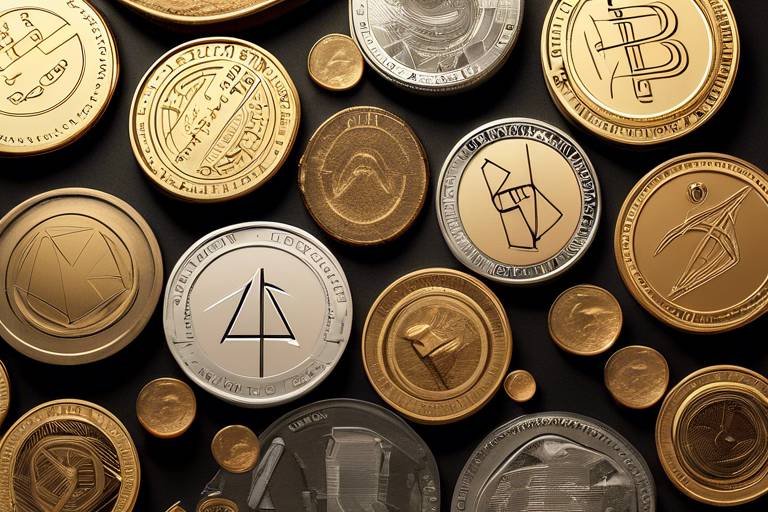Exploring Cross-Chain Solutions for Enhanced Connectivity
In the rapidly evolving world of blockchain technology, the need for seamless communication between different networks has never been more critical. Cross-chain solutions are emerging as a game-changer, enabling various blockchain platforms to interact with one another. Imagine a world where you can easily transfer assets from one blockchain to another without the hassle of complex processes or high fees. This is the essence of cross-chain technology, and it’s paving the way for a more interconnected digital landscape.
As we dive deeper into this topic, it's essential to understand that cross-chain solutions are not just about moving assets; they are about enhancing the overall user experience. By facilitating interoperability, these solutions can significantly improve the functionality of decentralized applications (dApps). For instance, consider a scenario where a user can seamlessly swap tokens across different platforms, access services, and leverage the unique features of various blockchains—all in one unified interface. This is the promise of cross-chain technology!
Moreover, as the blockchain ecosystem continues to grow, the importance of interoperability cannot be overstated. Just like how the internet connects various websites, cross-chain solutions aim to connect different blockchain networks, allowing them to share data and resources efficiently. This interconnectedness not only boosts scalability but also enhances the overall value proposition of blockchain technology.
In this article, we will explore the foundational principles of cross-chain technology, delve into the challenges and benefits of interoperability, and highlight some of the leading protocols that are making waves in this space. We'll also examine real-world applications and future trends that could redefine the blockchain landscape. So, buckle up as we embark on this fascinating journey into the world of cross-chain solutions!
- What is cross-chain technology? Cross-chain technology refers to the ability of different blockchain networks to communicate and interact with each other, enhancing the functionality of decentralized applications.
- Why is interoperability important? Interoperability is crucial for seamless transactions and data exchange across diverse blockchain platforms, fostering a more integrated ecosystem.
- What are some key cross-chain protocols? Notable protocols include Polkadot, Cosmos, and Chainlink, each offering unique features for cross-chain connectivity.
- What are the benefits of cross-chain solutions? Benefits include increased liquidity, reduced transaction costs, and improved user experiences across different blockchain networks.
- What challenges do cross-chain solutions face? Challenges include security concerns, technical complexities, and the need for standardization among different blockchain networks.

Understanding Cross-Chain Technology
Cross-chain technology is revolutionizing the way we think about blockchain networks. Imagine a world where different blockchains can talk to each other seamlessly, much like how people from different countries communicate through a common language. This technology allows for the **interconnection** of various blockchain platforms, enabling them to share data and execute transactions without the need for intermediaries. It’s a game-changer for decentralized applications (dApps), enhancing their functionality and broadening their use cases.
At its core, cross-chain technology is built on the principle of **interoperability**. This means that various blockchains, which often operate in isolation, can now interact and share information. Think of it as a bridge connecting islands in an ocean; just as bridges facilitate travel between islands, cross-chain solutions enable the flow of assets and data between different blockchain ecosystems. This connectivity is crucial for the evolution of blockchain technology, as it allows for a more integrated and cohesive digital landscape.
One of the foundational elements of cross-chain technology is the **use of protocols** that facilitate communication between different networks. These protocols can be likened to translators in a multilingual conference, ensuring that everyone understands each other despite speaking different languages. Examples of such protocols include Polkadot, Cosmos, and Chainlink, each offering unique features that cater to specific interoperability needs. By utilizing these protocols, developers can create applications that are not limited to a single blockchain, thus enhancing their reach and impact.
Moreover, the importance of cross-chain technology becomes even more evident when we consider the **growing demand for scalability**. As more users flock to blockchain platforms, the need for efficient transaction processing and data management becomes paramount. Cross-chain solutions can alleviate congestion by distributing workloads across multiple networks, much like how a busy highway can be relieved by opening alternative routes. This scalability not only improves user experience but also fosters innovation within the blockchain space, encouraging developers to create more robust and versatile applications.
In summary, cross-chain technology is not just a buzzword; it represents a fundamental shift in how blockchain networks can operate together. By breaking down the silos that have traditionally separated these networks, we are paving the way for a more interconnected and user-friendly blockchain ecosystem. The potential for collaboration and innovation is immense, and as we continue to explore and develop cross-chain solutions, we are likely to witness a transformation in the way digital assets and information are exchanged across the globe.
- What is cross-chain technology? Cross-chain technology enables different blockchain networks to communicate and interact, allowing for seamless data and asset transfers.
- Why is interoperability important? Interoperability is crucial for enhancing the functionality of decentralized applications and improving user experience by allowing transactions across various platforms.
- What are some examples of cross-chain protocols? Notable examples include Polkadot, Cosmos, and Chainlink, each designed to facilitate communication between different blockchain networks.
- How does cross-chain technology improve scalability? By distributing workloads across multiple networks, cross-chain solutions can reduce congestion and enhance transaction processing efficiency.

The Need for Interoperability
In the ever-evolving world of blockchain technology, interoperability stands out as a critical factor for progress. Imagine a world where different blockchain networks function like a well-oiled machine, effortlessly exchanging information and value without the cumbersome barriers that currently exist. This vision is not just a dream; it's a necessity for the future of decentralized systems. Without interoperability, the potential of blockchain remains largely untapped, much like a beautiful painting hidden away in a dark attic.
The primary challenge with blockchain networks today is that they often operate in silos. Each network has its own set of rules, protocols, and functionalities, which makes communication between them a Herculean task. For instance, if you want to transfer assets from Ethereum to Bitcoin, the process can be convoluted and costly, often involving multiple intermediaries or exchanges. This fragmentation leads to inefficiencies that can frustrate users and stifle innovation.
Interoperability aims to bridge these gaps, allowing for seamless transactions and data exchange across diverse platforms. The benefits are immense, including:
- Enhanced User Experience: Users can interact with multiple blockchains without needing to understand the underlying complexities.
- Increased Liquidity: Assets can move freely between networks, making it easier for users to access a broader range of financial instruments.
- Reduced Costs: By eliminating intermediaries, transaction fees can be significantly lowered.
However, achieving interoperability is not without its challenges. Security is a paramount concern; allowing different networks to communicate increases the potential attack surface for malicious actors. Moreover, technical complexities arise when trying to standardize protocols across various platforms. Developers must navigate these hurdles while ensuring that the systems remain robust and secure.
In summary, the need for interoperability in blockchain technology cannot be overstated. It is the key to unlocking the full potential of decentralized applications and services. By fostering an environment where different networks can collaborate, we pave the way for a more integrated and efficient digital economy. As we move forward, addressing the challenges of interoperability will be crucial in shaping the future of blockchain technology.

Key Cross-Chain Protocols
When we talk about cross-chain protocols, we're diving into a fascinating world where different blockchain networks can communicate with one another. This is crucial because, just like humans, blockchains need to collaborate to unlock their full potential. Imagine trying to have a conversation with someone who speaks a different language; without a common tongue, the message gets lost. Cross-chain protocols serve as that common language, facilitating seamless interactions among various blockchain ecosystems.
One of the most prominent cross-chain protocols is Polkadot. Polkadot is like a bustling train station where various trains (or blockchains) can arrive and depart. It allows different blockchains to operate together, sharing information and functionality. Polkadot achieves this through its unique architecture, which includes a central relay chain that connects multiple parachains. This not only enhances scalability but also ensures that each blockchain can maintain its own governance and features while still being part of a larger network.
Another key player in the cross-chain landscape is Cosmos. Often referred to as the "Internet of Blockchains," Cosmos aims to create an ecosystem where independent blockchains can easily communicate. It uses a technology called the Inter-Blockchain Communication (IBC) protocol, which allows for the transfer of data and tokens between different chains. Think of Cosmos as a universal translator that ensures blockchains can share information without barriers, promoting a more interconnected blockchain universe.
Then there's Chainlink, which is primarily known for its oracles—tools that connect smart contracts with real-world data. However, Chainlink also plays a crucial role in cross-chain interactions by enabling smart contracts on one blockchain to access data from another chain. This functionality is akin to a bridge that allows information to flow freely between islands (blockchains), enhancing the capabilities of decentralized applications (dApps).
To give you a clearer picture of how these protocols stack up, here's a comparison table:
| Protocol | Key Feature | Use Case |
|---|---|---|
| Polkadot | Relay chain and parachains | Multi-chain applications |
| Cosmos | Inter-Blockchain Communication (IBC) | Data transfer between blockchains |
| Chainlink | Smart contract oracles | Accessing external data |
Each of these protocols contributes uniquely to the cross-chain ecosystem, addressing different aspects of blockchain interoperability. By leveraging their capabilities, developers can create more robust, versatile, and user-friendly applications that transcend the limitations of individual blockchains. The potential here is enormous, and as these protocols continue to evolve, we can expect to see even more innovative solutions emerge.
In conclusion, understanding these cross-chain protocols is essential for anyone looking to navigate the complex landscape of blockchain technology. They not only enhance connectivity but also pave the way for a future where blockchain networks can work together seamlessly, much like a well-orchestrated symphony. With the right tools and frameworks, the possibilities are endless!
- What are cross-chain protocols? Cross-chain protocols are frameworks that allow different blockchain networks to communicate and share data with one another.
- Why is interoperability important? Interoperability is crucial because it enables seamless transactions and data exchange across diverse blockchain platforms, enhancing the overall functionality of decentralized applications.
- What are some examples of cross-chain protocols? Notable examples include Polkadot, Cosmos, and Chainlink, each offering unique features that enhance cross-chain connectivity.

Benefits of Cross-Chain Solutions
When we dive into the world of cross-chain solutions, it's like opening a treasure chest of opportunities. These solutions are not just another tech buzzword; they represent a significant leap forward in how blockchain networks can interact with one another. Imagine trying to communicate with a friend who speaks a different language. Cross-chain technology acts as a universal translator, allowing various blockchain networks to exchange information seamlessly. This capability brings several key benefits that are reshaping the blockchain landscape.
One of the standout advantages of cross-chain solutions is increased liquidity. In traditional finance, liquidity refers to how easily assets can be bought or sold without affecting their price. In the blockchain realm, liquidity can be a challenge due to the isolation of different networks. Cross-chain solutions enable assets to move freely across different platforms, effectively creating a more vibrant marketplace. This means users can trade assets more efficiently, leading to better prices and reduced slippage.
Another significant benefit is the reduction in transaction costs. When transactions are confined to a single blockchain, users often face higher fees, especially during peak times. By allowing transactions to occur across multiple chains, users can choose the most cost-effective route for their transactions. This not only saves money but also encourages more people to participate in the blockchain ecosystem. Think of it as shopping for the best deal; why pay more when you can find a better price elsewhere?
Moreover, cross-chain solutions enhance the user experience. Imagine using a single app to manage all your different cryptocurrencies and assets, regardless of the blockchain they are on. Cross-chain technology paves the way for integrated platforms where users can engage with multiple assets without needing to jump between different wallets or exchanges. This streamlined approach not only saves time but also reduces the complexity that often deters newcomers from entering the blockchain space.
To illustrate the impact of cross-chain solutions, consider the following table that summarizes their key benefits:
| Benefit | Description |
|---|---|
| Increased Liquidity | Facilitates smoother trading across different networks, enhancing asset availability. |
| Reduced Transaction Costs | Offers users the ability to choose cheaper transaction routes, lowering overall fees. |
| Enhanced User Experience | Provides a unified platform for managing various assets, simplifying user interactions. |
Furthermore, these solutions can drive innovation within the blockchain ecosystem. By breaking down the silos that exist between different networks, developers are encouraged to create new applications that leverage the strengths of multiple blockchains. This not only fosters creativity but also leads to the development of more robust and versatile decentralized applications (dApps).
In conclusion, the benefits of cross-chain solutions are profound and far-reaching. They not only enhance liquidity and reduce costs but also significantly improve the overall user experience. As the blockchain space continues to evolve, embracing cross-chain technology will be crucial for fostering a more interconnected and efficient digital economy. So, are you ready to explore the endless possibilities that cross-chain solutions offer?
- What are cross-chain solutions? Cross-chain solutions enable different blockchain networks to communicate and interact, allowing for seamless transactions and data exchange.
- How do cross-chain solutions increase liquidity? By allowing assets to move freely between networks, cross-chain solutions create a more vibrant trading environment, making it easier for users to buy and sell assets.
- Are cross-chain transactions more expensive? No, in fact, cross-chain solutions often reduce transaction costs by allowing users to choose the most cost-effective routes for their transactions.
- What impact do cross-chain solutions have on user experience? They simplify the management of multiple assets by integrating them into a single platform, making it easier for users to interact with different cryptocurrencies.

Challenges in Cross-Chain Integration
When we talk about cross-chain integration, it sounds like a dream come true for blockchain enthusiasts—like a bridge connecting islands of innovation. However, just like any ambitious project, it comes with its own set of challenges that can make even the most seasoned developers scratch their heads in confusion. One of the primary hurdles is security concerns. As these networks interact, the risk of vulnerabilities increases. Imagine a thief trying to break into a bank vault; the more access points there are, the easier it becomes for malicious actors to exploit weaknesses.
Another significant challenge is the technical complexity involved in creating seamless interoperability. Each blockchain has its own unique protocols, consensus mechanisms, and data structures. Integrating these disparate systems is akin to trying to fit a square peg into a round hole. Developers must navigate numerous protocols and standards, which can lead to delays and increased costs.
Moreover, the lack of established standards for cross-chain communication poses a significant barrier. Without a common language, different blockchains struggle to understand each other. This situation can lead to inefficiencies and delays in transaction processing. It's like trying to have a conversation with someone who speaks a different language—communication breakdowns are inevitable.
To illustrate these challenges further, consider the following table that outlines some of the key obstacles developers face:
| Challenge | Description |
|---|---|
| Security Risks | Increased vulnerabilities due to multiple access points. |
| Technical Complexity | Diverse protocols and consensus mechanisms create integration challenges. |
| Lack of Standards | Absence of a common language for blockchains leads to inefficiencies. |
Furthermore, the issue of scalability cannot be overlooked. As more users and transactions flow through these interconnected networks, the demand on each blockchain increases. If one chain becomes congested, it can slow down the entire system, leading to frustrating delays for users. It's like a traffic jam on a busy highway; when one lane is blocked, everyone suffers.
Lastly, let's not forget about the regulatory landscape. As cross-chain solutions continue to evolve, they may face scrutiny from regulatory bodies. Navigating the legal implications of cross-chain transactions can be daunting, and uncertainty in regulations can deter innovation. Developers may find themselves in a constant tug-of-war between compliance and creativity.
In summary, while cross-chain integration offers exciting possibilities, it is not without its challenges. Security, technical complexity, lack of standards, scalability issues, and regulatory hurdles all play a significant role in shaping the future of cross-chain technology. Overcoming these obstacles will require collaboration, innovation, and a commitment to creating a more interconnected blockchain ecosystem.

Real-World Applications
Cross-chain solutions are not just theoretical concepts; they are making significant waves across various industries today. Imagine a world where different blockchain networks can seamlessly communicate with each other, enabling a plethora of innovative applications that were previously thought impossible. This is the reality that cross-chain technology is creating, and its impact is profound.
One of the most notable applications of cross-chain solutions is in the financial sector. Traditional financial systems are often siloed, making it challenging to transfer assets between different platforms. With cross-chain technology, users can easily move cryptocurrencies and tokens from one blockchain to another without the need for cumbersome exchanges. For instance, platforms like Polkadot allow users to execute transactions across various blockchains, enhancing liquidity and enabling more efficient trading strategies.
Moreover, the decentralized finance (DeFi) space is booming, and cross-chain solutions play a pivotal role in its expansion. By allowing assets to flow freely between different DeFi platforms, users can take advantage of the best rates, yield farming opportunities, and liquidity pools without being restricted to a single blockchain. This interoperability not only maximizes returns but also fosters a more competitive environment for DeFi projects.
In addition to finance, the supply chain management industry is also reaping the benefits of cross-chain technology. Companies are using blockchain to track goods and ensure transparency throughout the supply chain. With cross-chain solutions, stakeholders can access real-time data from multiple blockchains, enhancing traceability and accountability. For instance, a product's journey from the manufacturer to the retailer can be tracked across various networks, providing consumers with verified information about the product's origin and handling.
Furthermore, the gaming industry is witnessing a transformation thanks to cross-chain solutions. Players can now own in-game assets that are not confined to a single game or platform. By utilizing cross-chain technology, gamers can trade their assets across different games and platforms, creating a vibrant ecosystem where digital assets hold real value. This not only enhances player engagement but also opens up new revenue streams for developers.
Lastly, the healthcare sector is exploring the potential of cross-chain solutions to improve patient data management. By allowing different healthcare providers to share and access patient records across various blockchain networks, cross-chain technology can enhance patient care, reduce administrative costs, and ensure data integrity. Imagine a scenario where a patient's medical history is securely shared between their primary care physician and specialists, leading to more informed treatment decisions.
In summary, the real-world applications of cross-chain solutions are diverse and impactful. From finance to gaming and healthcare, the ability to bridge different blockchain networks is revolutionizing industries and creating new opportunities for innovation. As we continue to explore these applications, it's clear that cross-chain technology is not just a trend but a fundamental shift in how we interact with digital assets.
- What are cross-chain solutions? Cross-chain solutions are technologies that enable different blockchain networks to communicate and interact with each other.
- Why is interoperability important? Interoperability allows for seamless transactions and data exchange, enhancing the overall functionality of decentralized applications.
- What industries are benefiting from cross-chain technology? Industries such as finance, supply chain management, gaming, and healthcare are leveraging cross-chain solutions for improved efficiency and transparency.
- Are there any challenges in implementing cross-chain solutions? Yes, challenges include security concerns and technical complexities that developers and users must navigate.

Future Trends in Cross-Chain Development
As we look ahead, the landscape of cross-chain development is poised for significant evolution. The increasing demand for interoperability among blockchain networks is driving innovation and pushing developers to explore new methodologies that enhance connectivity. One of the most exciting trends is the rise of layer-2 solutions, which aim to improve scalability and speed while maintaining security. These solutions can facilitate seamless transactions across multiple chains, making it easier for users to navigate the fragmented blockchain ecosystem.
Another noteworthy trend is the integration of decentralized finance (DeFi) with cross-chain capabilities. As DeFi continues to gain momentum, the need for platforms that can operate across different blockchains becomes increasingly critical. This integration will not only enhance liquidity but also create a more inclusive financial environment where users can access a broader range of financial services without the limitations imposed by single-chain ecosystems.
Moreover, we are witnessing the emergence of cross-chain bridges, which serve as connectors between distinct blockchain networks. These bridges enable assets to move freely across platforms, thereby increasing the potential for collaboration and innovation across the blockchain space. For example, projects like Thorchain and Wormhole are leading the way by allowing users to swap assets across different chains without the need for centralized exchanges. This not only enhances user experience but also fortifies the decentralized nature of blockchain technology.
On the technical side, advancements in smart contract interoperability are set to redefine how decentralized applications (dApps) function. By enabling smart contracts to communicate with one another across different blockchains, developers can create more complex and feature-rich applications. This could lead to a new wave of dApps that leverage the strengths of multiple networks, providing users with a more versatile and robust experience.
Lastly, the growing focus on security protocols in cross-chain solutions cannot be overlooked. As more assets traverse various chains, ensuring the security of these transactions becomes paramount. Future developments will likely include enhanced cryptographic techniques and multi-signature wallets that bolster protection against potential vulnerabilities. This focus on security will not only instill greater confidence in users but also encourage broader adoption of cross-chain technologies.
In summary, the future of cross-chain development is bright, characterized by innovative solutions that enhance interoperability, security, and user experience. As the blockchain ecosystem continues to mature, we can expect to see a plethora of new tools and technologies that will bridge the gaps between networks, ultimately leading to a more interconnected digital landscape.
- What are cross-chain solutions? Cross-chain solutions enable different blockchain networks to communicate and interact, enhancing the overall functionality of decentralized applications.
- Why is interoperability important? Interoperability allows for seamless transactions and data exchange across diverse platforms, which is crucial for the evolution of blockchain technology.
- What are some examples of cross-chain protocols? Leading protocols include Polkadot, Cosmos, and Chainlink, each contributing uniquely to cross-chain connectivity.
- What benefits do cross-chain solutions offer? They increase liquidity, reduce transaction costs, and enhance user experience across blockchain networks.
- What challenges do cross-chain solutions face? Key challenges include security concerns and technical complexities that developers must navigate when implementing these technologies.

Conclusion: The Path Forward
As we navigate the rapidly evolving landscape of blockchain technology, it becomes increasingly clear that cross-chain solutions are not just a luxury but a necessity. They pave the way for a more interconnected digital world where various blockchain networks can communicate seamlessly, creating a robust ecosystem that is both scalable and user-friendly. The potential of these solutions is immense, and their ability to enhance interoperability is crucial for the future of decentralized applications.
Looking ahead, the path forward for cross-chain technology is filled with promise. As developers and innovators continue to tackle the challenges of security and technical complexity, we can anticipate a wave of advancements that will further solidify the relevance of cross-chain solutions. Imagine a world where transferring assets across different blockchain networks is as easy as sending an email—this is the future that cross-chain technology aims to create.
Moreover, as industries from finance to supply chain management begin to adopt cross-chain solutions, we will likely witness a transformation in traditional processes. The ability to reduce transaction costs and increase liquidity can lead to more efficient operations and greater accessibility for users. This democratization of technology will empower individuals and businesses alike, fostering innovation and growth.
In conclusion, the journey towards enhanced blockchain connectivity is just beginning. As we embrace the challenges and opportunities presented by cross-chain solutions, we must remain committed to collaboration and innovation. By doing so, we can unlock the full potential of blockchain technology, creating a future that is not only interconnected but also inclusive and equitable.
- What are cross-chain solutions? Cross-chain solutions enable different blockchain networks to communicate and interact, enhancing the functionality of decentralized applications.
- Why is interoperability important? Interoperability allows for seamless transactions and data exchange across diverse platforms, which is crucial for the evolution of blockchain technology.
- What are some key cross-chain protocols? Notable cross-chain protocols include Polkadot, Cosmos, and Chainlink, each contributing uniquely to cross-chain connectivity.
- What benefits do cross-chain solutions offer? Benefits include increased liquidity, reduced transaction costs, and an enhanced user experience, positively impacting the broader blockchain ecosystem.
- What challenges do cross-chain solutions face? Challenges include security concerns and technical complexities that developers and users must navigate.
- What are the future trends in cross-chain development? Ongoing advancements and research are expected to redefine blockchain interoperability, leading to innovative applications across various industries.
Frequently Asked Questions
- What is cross-chain technology?
Cross-chain technology refers to the ability of different blockchain networks to communicate and interact with each other. This innovation enhances the functionality of decentralized applications, allowing them to operate across multiple platforms seamlessly. Imagine being able to send a message from your smartphone to a landline without any hassle—cross-chain technology does just that for blockchains!
- Why is interoperability important in blockchain?
Interoperability is crucial because it allows for seamless transactions and data exchange across various blockchain platforms. Without it, blockchains operate in silos, limiting their potential. Think of it like different countries using their own currencies without a way to exchange them—interoperability breaks down those barriers, making interactions smoother and more efficient.
- What are some key cross-chain protocols?
Some of the leading cross-chain protocols include Polkadot, Cosmos, and Chainlink. Each of these protocols has unique features and use cases that contribute to enhancing cross-chain connectivity. For instance, Polkadot allows multiple blockchains to transfer messages and value in a trust-free fashion, while Cosmos focuses on building an internet of blockchains.
- What benefits do cross-chain solutions offer?
Implementing cross-chain solutions can lead to increased liquidity, reduced transaction costs, and an overall enhanced user experience. With more options available for transactions and interactions, users can enjoy a more fluid and cost-effective experience in the blockchain ecosystem. It's like having a universal remote that controls all your devices at once—convenient and efficient!
- What challenges do developers face in cross-chain integration?
Despite their potential, cross-chain solutions face several challenges, including security concerns and technical complexities. Developers often encounter issues related to ensuring the safety of transactions across different networks and managing the intricacies of integrating various blockchain technologies. It's akin to trying to connect different types of puzzle pieces; not all fit together easily!
- Can you provide examples of real-world applications of cross-chain solutions?
Absolutely! Cross-chain solutions are being utilized in various industries, from finance to supply chain management. For example, in finance, cross-chain technology enables users to trade assets across different exchanges without the need for intermediaries. In supply chain management, it helps track products across different networks, enhancing transparency and efficiency.
- What are the future trends in cross-chain development?
The future of cross-chain technology looks promising, with ongoing advancements and research paving the way for new innovations. Emerging trends may include improved security measures, more user-friendly interfaces, and enhanced scalability solutions. As the blockchain landscape evolves, we can expect cross-chain solutions to become even more integral to the ecosystem.



















